[Contrapuntal Forms]
[Conversation with Magic Stones]
[Back to Rhythm of the Stones]

from Guico Delle Coppe
Jeux Diurnes (Late Afternoon Games) the music might be regarded as what goes on ‘outside the sculpture’; what surrounds it, or how it might be encountered. The music plays games with itself spinning a contrapuntal web of patterns, woven by each player into a whole. Like the fantasias of Orlando Gibbons there is often intense imitation between each instrumental part.
[Introduction]
[Ascending Form]
[Contrapuntal Forms]
[Conversation with Magic Stones]
[Back to Rhythm of the Stones]

from Jeux Diurnes
[Introduction]
[Ascending Form]
[Contrapuntal Forms]
[Conversation with Magic Stones]
[Back to Rhythm of the Stones]
Circling round ‘Contrapuntal Forms’
The little bush counts to a hundred
in the centre of the cobbled forecourt.
When it opens its eyes there is no-one
in passages under flats, or concealed
in washing drying on balconies
or between cars staring each other out.
A little wall shouts ‘Boo’ in the face
of a cherry tree, and runs away
scuffling petals and tripping
on a partial pavement.
Hide and seek
seems to have given way
to Oranges and Lemons; terraces
and flats polarised and pulling
across the road with speed humps
where a man has appeared and
thoughtfully walks round his car.
Two blue limestone forms
play in a corner.
“Is this ‘Follow my Leader’?”
“No. It’s ‘If you are moving
when I turn my head you are out.’”

[Introduction]
[Ascending Form]
[Contrapuntal Forms]
[Conversation with Magic Stones]
[Back to Rhythm of the Stones]
Then they come face to face.
Time to play secrets. “Here,
by this cherry tree and in the presence
of all these windows, I whisper
a secret. You are part of me, but
not part of me.
![]() Or shall
Or shall
we
pretend to be Chicken Licken,
because, you must see,
the sky is falling in, freezing
into a glacier between us,
keeping us apart.” “So let’s play
at being statues. Stay still.”
“It’s melting now. Come closer.
And closer. Let’s play at experimental
childish sex.
under these cherry trees.
The Resident upon his balcony
Dreams among his flowers while below
Juliet leans towards her Romeo.
And washing swats at the intruding sun
Which still gains entrance, waves from windowpanes,
Gradually mounting stairs, yawns from bedrooms
While owl, cat, fox and party-goers
Serenade the evening their own way.
Maybe tomorrow a faint white heart
Will tell a limestone lie about falling in love.
– Margaret Morgan 2003

[Introduction]
[Ascending Form]
[Contrapuntal Forms]
[Conversation with Magic Stones]
[Back to Rhythm of the Stones]

from Guico Delle Coppe
Scoring and Performance Instructions
The music is scored for a ‘quartet of timbres’. The instrumentation is not fixed but constrained to the idea that the quartet should be played by instruments of different or opposing timbres. The ideal ensemble might bring together wind, brass, percussion and string timbres, indeed the initial ‘model’ was imagined for soprano sax, bass trombone, marimba, and cello. This is not a work to be attempted by a string quartet!
Although some detailed articulations will be found on the score these markings should only be considered a guide, no more. Dynamics per se are not indicated. Octave transposition of and within phrases is encouraged to secure the best ‘fit’ of instrument to part.
In Guico Delle Coppe complex phrases within each quarter beat may be treated with an improvisational flourish rather than with mechanical exactitude.
The rehearsal letters in each movement indicate the sections of the musical structure. Players are encouraged to give these sections different characters using specific dynamics or tempo.
Contrapuntal Forms was devised using the beat-space scoring approach invented by Milton Babbitt in his Composition for Four Instruments of 1948. Here, the ordering and combining of instrumental parts is the first compositional decision from which everything else flows. Like many of Babbitt’s scores the style of performance is also closer to Modern Jazz than Classical Chamber Music.
Downloads
Score [pdf]
Recording by BBCNOW quartet I [mp3]
II [mp3]
Web presentation [swf]
